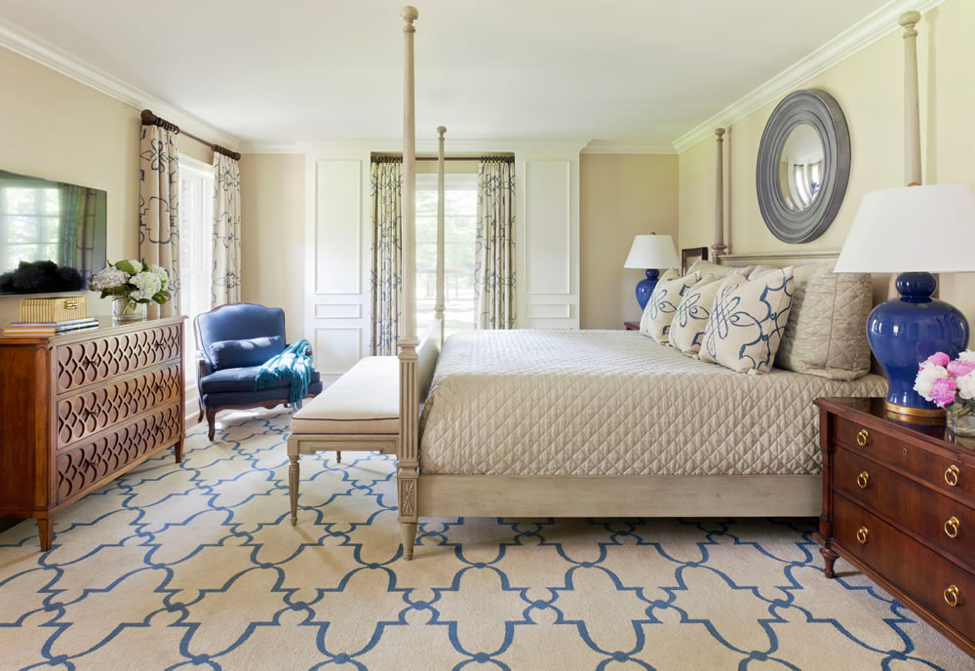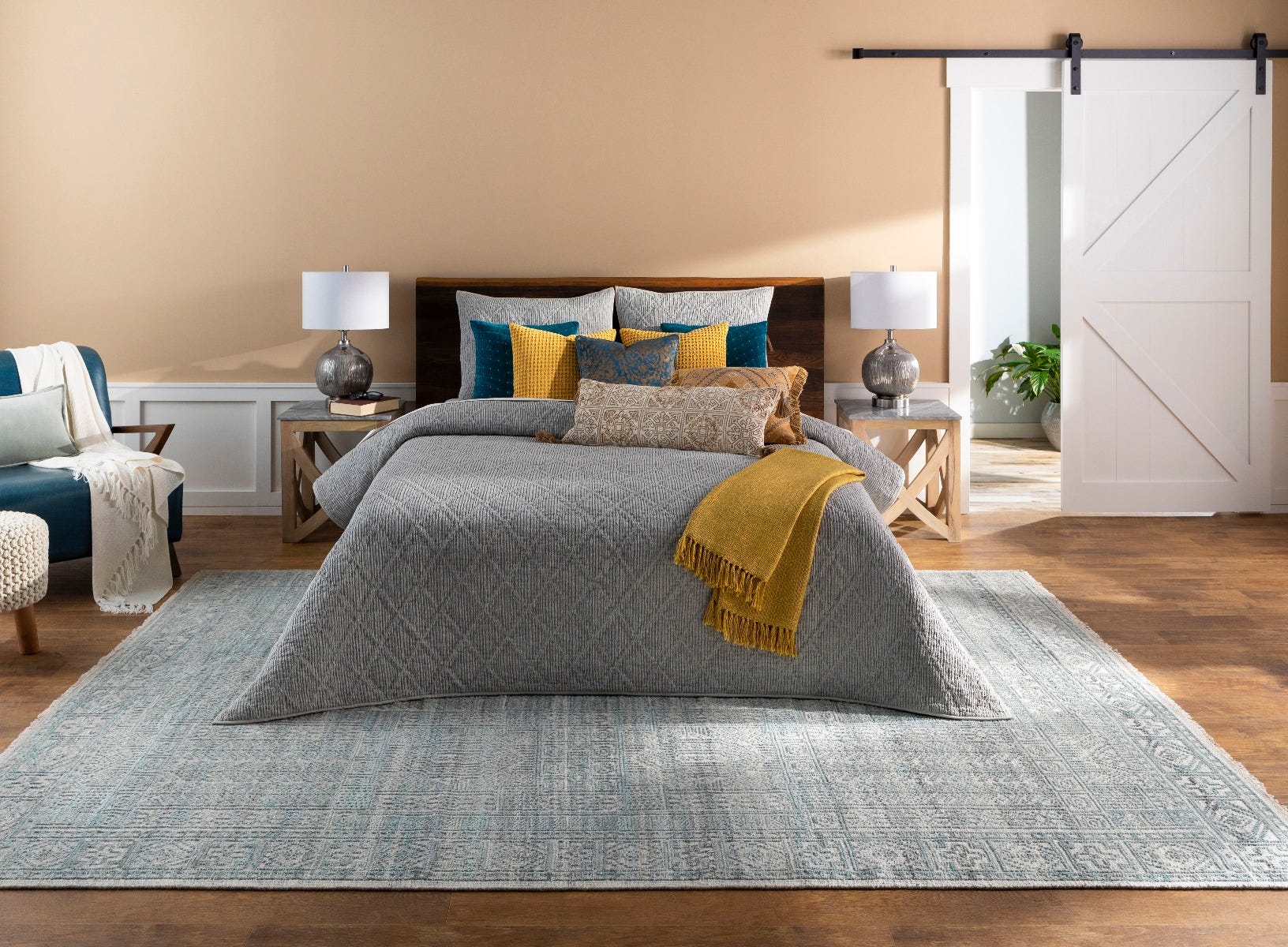Wall-to-Wall Carpet

Wall-to-wall carpeting, as the name suggests, covers the entire floor of a room, creating a seamless and unified look. This type of carpeting is a popular choice for bedrooms, offering numerous benefits that enhance comfort, insulation, and aesthetics.
Types of Carpet Fibers
Carpet fibers are the foundation of any carpet, and the choice of fiber can significantly impact the carpet’s durability, appearance, and feel. Common carpet fibers used for wall-to-wall bedroom carpeting include:
- Nylon: Known for its exceptional durability, resilience, and stain resistance, nylon is a popular choice for high-traffic areas. It’s also relatively affordable, making it a versatile option for bedrooms.
- Polyester: Offering a soft and luxurious feel, polyester is another durable option that resists fading and stains. It’s often chosen for bedrooms due to its affordability and versatility.
- Wool: Renowned for its natural beauty, warmth, and resilience, wool is a premium choice for bedrooms. It’s naturally stain-resistant and fire-retardant, providing both comfort and durability.
- Olefin: Known for its affordability and stain resistance, olefin is a synthetic fiber often used in bedrooms. It’s also moisture-resistant, making it suitable for areas prone to spills or humidity.
- Triexta: A newer synthetic fiber, triexta offers a soft and luxurious feel similar to wool, with added durability and stain resistance. It’s an increasingly popular choice for bedrooms, offering a blend of comfort and practicality.
Selecting the Right Carpet Color and Pattern
Choosing the right carpet color and pattern for your bedroom is crucial for creating a cohesive and inviting space. Consider these factors when making your selection:
- Room Size: Lighter colors and smaller patterns can make a small bedroom feel larger, while darker colors and bold patterns can create a more intimate and cozy atmosphere in a larger room.
- Furniture: The color and style of your furniture should complement the carpet. Consider using a neutral carpet color to allow your furniture to stand out, or choose a bolder color to create a unified look.
- Personal Preferences: Ultimately, the most important factor is your personal preference. Choose a carpet color and pattern that you love and that reflects your style.
Installation and Maintenance: Wall To Wall Bedroom Carpet

Installing wall-to-wall carpet in a bedroom is a relatively straightforward process that can significantly enhance the room’s comfort and aesthetics. Proper installation ensures a seamless and long-lasting carpet, while consistent maintenance preserves its beauty and longevity.
Preparing the Subfloor, Wall to wall bedroom carpet
Before laying the carpet, it’s crucial to prepare the subfloor to ensure a smooth and even surface. This step is essential for preventing bumps, dips, and unevenness that can affect the carpet’s appearance and longevity.
- Inspect and repair: Carefully inspect the subfloor for any damage, such as cracks, gaps, or loose boards. Repair any issues using appropriate methods, like patching or replacing damaged sections.
- Leveling: If the subfloor is uneven, use a leveling compound to create a smooth and consistent surface. This ensures the carpet lays flat and avoids premature wear.
- Moisture barrier: Install a moisture barrier to protect the subfloor from moisture damage, especially in areas prone to humidity. This helps prevent mold growth and extends the carpet’s lifespan.
Installing Carpet Padding
Carpet padding is an essential component that plays a crucial role in enhancing comfort, sound insulation, and extending the carpet’s lifespan. It acts as a cushioning layer between the subfloor and the carpet, absorbing impact and reducing wear.
- Types of padding: Various types of padding are available, including foam, rubber, and rebond. Choosing the right padding depends on factors such as the carpet’s thickness, traffic levels, and desired level of comfort.
- Installation: Install the padding by rolling it out over the prepared subfloor, ensuring it’s smooth and free of wrinkles. Secure the padding using staples or tack strips along the edges.
- Thickness: The thickness of the padding depends on the carpet’s thickness and the desired level of comfort. Thicker padding provides more cushioning and sound insulation, while thinner padding is suitable for low-traffic areas.
Laying the Carpet
Laying the carpet is the final step in the installation process. It requires precision and care to ensure a seamless and aesthetically pleasing finish.
- Measuring and cutting: Measure the room accurately and cut the carpet to the required size, leaving a few extra inches for trimming.
- Seaming: If the carpet needs to be seamed, use a carpet seam tape and a seam iron to create a strong and invisible join.
- Installation: Starting from one corner, carefully lay the carpet, stretching it taut to remove wrinkles and ensure a smooth fit.
Finishing the Edges
Finishing the edges of the carpet is crucial for a professional look and to prevent fraying. This involves securing the carpet along the perimeter of the room.
- Tack strips: Install tack strips along the walls to hold the carpet in place. These strips have sharp points that grip the carpet backing.
- Carpet grippers: Use carpet grippers to secure the carpet in areas where tack strips are not suitable, such as under cabinets or furniture.
- Trimming: Trim any excess carpet using a sharp utility knife, ensuring a clean and even finish.
Maintaining Wall-to-Wall Carpet
Regular maintenance is essential for preserving the appearance and extending the lifespan of wall-to-wall carpet. It involves a combination of regular cleaning and occasional professional care.
- Vacuuming: Vacuum the carpet regularly, at least once or twice a week, to remove dust, dirt, and debris. This helps prevent the accumulation of dirt and grime, which can damage the carpet fibers.
- Stain removal: Address spills and stains promptly to prevent them from setting in. Use appropriate stain removers and follow the manufacturer’s instructions carefully.
- Professional cleaning: Schedule professional carpet cleaning every 12-18 months to remove deep-seated dirt and grime that regular vacuuming cannot reach. This helps refresh the carpet and maintain its appearance.
Wall-to-Wall Carpet in Bedroom Design

Wall-to-wall carpeting is a timeless choice for bedrooms, offering a variety of benefits that contribute to a cozy and inviting atmosphere. From its sound-absorbing qualities to its ability to enhance the overall aesthetic appeal of a space, wall-to-wall carpet provides a range of advantages that make it a popular choice for homeowners.
Carpet Material Comparison
Choosing the right carpet material is essential for creating a bedroom that meets your specific needs and preferences. Each material has its own unique set of pros and cons.
| Material | Pros | Cons |
|---|---|---|
| Wool | Naturally durable, stain-resistant, sound-absorbing, hypoallergenic, luxurious feel | More expensive than other options, can be prone to shedding, requires regular cleaning and maintenance |
| Nylon | Durable, stain-resistant, resilient, affordable, available in a wide range of colors and styles | Can be less soft than wool, may not be as sound-absorbing, can be prone to static cling |
| Polyester | Soft, affordable, stain-resistant, available in a wide range of colors and styles, easy to clean | Not as durable as nylon or wool, can be prone to matting and crushing, may not be as sound-absorbing |
| Natural Fibers (e.g., sisal, jute) | Eco-friendly, durable, naturally hypoallergenic, unique texture and appearance | Can be more expensive, less soft than other options, may require special cleaning techniques |
Bedroom Layout and Versatility
Wall-to-wall carpet can be used to create a variety of different bedroom layouts, depending on the size and shape of the room and the desired aesthetic.
“A strategically placed area rug can help to define different zones within the bedroom, such as a reading nook or a dressing area.”
For example, a small bedroom can benefit from a simple layout with a bed placed against one wall and a nightstand on each side. The carpet can be used to create a sense of spaciousness by choosing a light color or a pattern that flows seamlessly throughout the room.
In a larger bedroom, a more elaborate layout can be achieved by incorporating additional furniture pieces, such as a dresser, a desk, or a seating area. The carpet can be used to define different zones within the bedroom, such as a reading nook or a dressing area.
Wall-to-Wall Carpet Styles
Wall-to-wall carpet comes in a wide range of styles, from classic and traditional to modern and contemporary.
“The choice of carpet style can significantly impact the overall feel of the bedroom, so it is important to consider the desired aesthetic and the existing decor.”
Classic and Traditional
This style typically features a simple, elegant design with a neutral color palette. Common patterns include stripes, damask, and floral motifs. Classic and traditional carpets are often made from wool or nylon and are known for their durability and timeless appeal.
Modern and Contemporary
Modern and contemporary carpet styles are characterized by bold colors, geometric patterns, and abstract designs. These carpets can add a touch of drama and sophistication to a bedroom. They are often made from nylon or polyester and are known for their versatility and ability to complement a wide range of decor styles.
Textured and Plush
Textured and plush carpets offer a luxurious feel and can add a touch of warmth to a bedroom. They are often made from wool or nylon and are available in a variety of colors and patterns.
Patterned and Geometric
Patterned and geometric carpets can add visual interest to a bedroom and help to create a sense of depth and dimension. They are available in a wide range of colors and patterns, from subtle and understated to bold and dramatic.
Wall to wall bedroom carpet – Wall-to-wall carpet can create a cozy and inviting atmosphere in a bedroom, but it can also be a challenge to maintain, especially in a high-traffic area like a guest room. If you’re looking for ways to maximize space and style in your guest room, consider incorporating guest bedroom twin bed ideas that include a rug instead of wall-to-wall carpet.
A rug can define the space and add a touch of personality, while also being easier to clean and replace.
Wall-to-wall carpeting can be a cozy and comfortable choice for a bedroom, but it can also make a small space feel even smaller. If you’re looking for ways to maximize space in your bedroom, consider incorporating a futon. A futon can serve as both a sofa and a bed, making it a perfect solution for small bedrooms.
For more inspiration on how to design a small bedroom with a futon, check out these small bedroom ideas with a futon. While a futon can help with space-saving, remember that wall-to-wall carpeting can still be a great choice for adding warmth and softness to your bedroom, especially if you opt for lighter colors to create an airy feel.